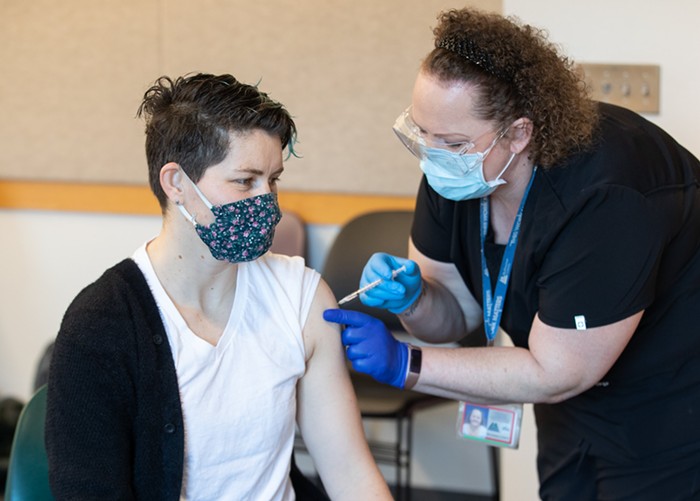AS THE DRY, hot summer temperatures wane into the wet autumn lows, it's easy to forget our world is changing—but it is.
Increased levels of carbon dioxide (CO2) and other greenhouse gases farting out the backside of human industry are accelerating our planet's metamorphosis from a stable and cool climate, to an increasingly erratic and much hotter one. And this summer we caught a glimpse of our future.
This year, the United States experienced the warmest July ever recorded. All told it was the third hottest summer on record in the lower 48 states. Next in line was last year, then 1936, the hottest year ever recorded, when the Dust Bowl ravaged the Great Plains. The dog days of 2012 were no Dust Bowl, but they weren't a picnic either. Midwesterners lived through the worst drought since 1956, while Coloradoans experienced some of the most devastating fires in their state's history. And Arctic ice defied the experts, proving it could melt much faster than anyone ever expected. As an Oregonian and a Portlander, you probably didn't feel the misery of smoke, drought, and heat. But your good fortune won't last.
By 2100, the Northwest will be anywhere from 3-10 degrees Fahrenheit hotter than it is today, and this will have real consequences. Imagine an Oregon with narrow, vanishing beaches. Imagine an Oregon where ski resorts close because it now rains instead of snows; an Oregon more and more dependant on irrigated agriculture, where pathogen-laden mosquitoes proliferate in ditches surrounding our fields; an Oregon where shellfish dissolve in acidic waters, water that is too low in oxygen for fish to breathe; an Oregon where scorching heat conspires with air pollution, forest fires, and higher pollen counts to make folks gasp for breath. Imagine an Oregon that, despite all this, is an Eden compared to the rest of the US and world, and for this reason is inundated by desperate climate refugees. Picture all this and you've got a pretty good idea of our region's bleak future. Consider what follows to be your—by no means exhaustive—cheat sheet to Oregon's climate-changed future, a guidebook to possibilities that range from bad to biblical.
_________________________________________________________________________________________
The Basics
We burn fossil fuels to power our cars, homes, and businesses. The end result of this is CO2, which accumulates in the atmosphere, trapping the sun's heat and producing global warming. You know that much. You might also know that human-caused global warming has been happening since the first cave people burned wood to ward off those frigid Ice Age nights—but it was the Industrial Revolution with its lung-choking smokestacks that gave the process a real shot in the arm. In the past 150 years, atmospheric CO2 has gone up 37 percent. Records for the past 100 years show the Earth's temperature has risen by nearly 1.5 degrees. And we'll be seeing the repercussions, even here.
_________________________________________________________________________________________
Water
Climatologists can't decide if Oregon's getting wetter or drier. But the general consensus is this: If we're moving into a wetter world, future precipitation will most likely fall in the winter, while our summers will be drier. And more crucial still, what precipitation we do get is more likely to descend as rain—not snow. That tiny factoid could lead to water scarcities even if we get wetter. It could also mean Oregonians will fight over our sparse water.
If you live to see mid-century, you could see low-elevation Cascade mountain ski resorts like Willamette Pass Resort, Hoodoo, and Mt. Hood Skibowl struggling because of a lack of snow on their slopes. More importantly, a hotter Oregon with less snow means water scarcity, especially during the summer months when somewhere from 60 to 80 percent of Willamette River flow now comes from Cascade winter snow melt. That's water for thirsty cities and thirsty agriculture—all of which need to be satiated. In the future we won't be able to depend on this water.
We're getting hotter, and that, says Eric Sproles, a researcher at the Environmental Protection Agency, is more important than any extra moisture the Earth's new erratic weather might award us. That's because we currently have no good way to store extra water. Up until now, we humans have let nature stockpile our future water in the form of mountain snowpack. Think of this as a water savings account set aside for those hot, rainless summers. To date, our snow savings has been pretty dependable. In the future it won't be. And this will have serious consequences for the Willamette Valley, which is not only one of the state's more fertile and productive regions, it's also one of the state's more populous. What's more, the region is projected to add an additional 350,000 people to the 1.1 million already there. That's nearly a half million more thirsty mouths competing with parched crops for water. And agriculture will be thirsty. With just a 1.8 degree rise in temperature, farmers are expected to need 10 percent more water than now—and it will get a lot hotter than that.
By mid-century, the Cascades are expected to have less than half of their existing snowpack, and as time passes and the thermostat rises, melting will increase. Currently the Cascades have dependable snowpack at around 4,600 feet above sea level. Below that is the less-than-dependable mark, which drops to about 2,600 feet. At that zone, precipitation either falls as snow or rain depending on the temperature. That means even minuscule increases in winter temps will produce rain instead of snow. That translates into more frequent and more extreme winter and springtime floods and an even less reliable snow savings account. If that weren't bad enough, these moisture zones are climbing ever higher year by year.
As a general rule of thumb, for every 2 degree rise, expect the zones to gain another 500 feet in elevation. And while climatologists are reluctant to make estimates past 2100, our water problems won't stop at that calendar date.
A group called Willamette Water 2100 is currently trying to figure out just how many people might be affected and what the potential economic impacts will be. Solutions discussed by the group include rationing water and discouraging consumption by upping its price tag. The group is also examining possible storage solutions. Despite this, Willamette Water 2100's Roy Haggerty warns we should expect legal fights over water—especially between farmers and city dwellers.
But fear not, Portlander, your water already comes mostly from rainwater. The city also uses an aquifer that's replenished by rain and the Columbia River. Just don't be shocked if your neighbors envy you. Things will be way crummier in the Willamette Valley and worse still east of the Cascades.
_________________________________________________________________________________________
Health
If you're an average Portlander—median age 36—chances are you'll live to see many of these changes. So consider yourself at the halfway point between what is and what will be. By mid-century, if you're doing well, you'll be retired or thinking about retiring. You'll also be the right age to suffer in our brave new world.
As agriculture becomes more dependent on irrigation, expect more insect-borne diseases like West Nile to lurk in the state's ditches. Rising temperatures also mean increased chances of heat stroke, which you, as an old fogey, will be particularly susceptible to. By mid-century—and, end of century should you live so long—expect the air quality to be much worse.
The rise in atmospheric CO2 will make the region's plants more productive and that means more pollen blowing about. Molds will also be on the rise, and there will be smoke.
By mid-century, the Pacific Northwest should expect 78 percent more of its forests burned in fires. By the end of the century, the scenario is bleaker with the total incinerated area jumping 500 percent from today's levels. As the infernos spread, expect potential damage to watersheds, which will muck up your drinking water. And as mentioned, fires will worsen the state's air quality. But if you think you can avoid the poor air by staying out of the allergen-packed valley and the smoldering hills, think again.
The reason is ground-level ozone, the main ingredient in urban smog. This "bad" ozone (as opposed to the good ozone in the stratosphere) forms when sunlight cooks volatile organic compounds from human—mostly tailpipe—exhaust, and natural sources with nitrogen oxides. The resulting ozone gas is known to trigger asthma attacks especially among children. But because ozone is heat sensitive, says Portland State University researcher Kelley Barsanti, unless we do everything right and outlaw cars and even some ozone-enabling vegetation from Portland, a warmer future still equals more ozone.
All this wheezing, sneezing, heat exhaustion, and various disease vectors are expected to cost the state a lot of money. The numbers broken down by Climate Leadership Initiative and ECONorthwest look like this: Under a high-emissions scenario, health care costs attributed to global warming are expected to rise by $1.3 billion by 2040, and $2.6 billion by 2080. There go your savings.
_________________________________________________________________________________________
The Ocean
By the end of the century, Oregon will weather more thunderstorms, hail, and even tornados than ever before. And the land will look different. By then, plants more common in Southern Oregon—including Ponderosa pines and deciduous trees—will have endured their slow trudge northward. The Douglas firs will still be there, but in the mountains overlooking the valley, the sub-alpine firs will have vanished with the snow. But the biggest changes by far will happen on the coast. In fact they're happening already.
In July 2002, the Oregon Department of Fish and Wildlife received a deluge of reports from Oregon crabbers that their traps were coming up full of dead crabs. Researchers at Oregon State University (OSU) later concluded the sea critters were suffocating to death because there wasn't enough oxygen in their coastal waters.
Called hypoxia, this choking sea-life phenomenon isn't just an issue in Oregon, it's global. While most hypoxia originates when fertilizer runoff feeds algae blooms (which in turn suck up water's dissolved oxygen, thereby suffocating fish and producing "dead zones"), Oregon's hypoxia, says OSU researcher Jack Barth, appears to be overwhelmingly climate-change driven, and, he says, we're not the only ones dealing with this problem.
Rising global temperatures are keeping the world's oceans from collecting oxygen. Basically, our oceans are full of currents going this way and that, and rising temperatures are decelerating their natural circulation. Seawater that reaches Oregon today is taking longer to get here than ever before. On its slow journey it loses oxygen. The water's also less oxygenated because it's warmer, and warmer water holds less oxygen. As a consequence, hypoxic dead zones have started appearing off the world's coasts, including our own.
"The more we study this, the more we see consistent change across the globe," says Barth, "the more it lends itself to a climate-change scenario." What this means for Oregon's fisheries is still unknown. Fish seem to flee the oxygen-deprived waters when they can, while the less mobile invertebrates are considerably less lucky. Barth says he and others haven't quite pinned hypoxia on human-caused climate change—yet. But a closely related phenomenon has our fingerprints all over it.
Atmospheric CO2 is now wandering into our oceans, and in the process, Oregon's coastal waters are becoming more acidic. The phenomenon was first noticed here several years ago when a Tillamook shellfish hatchery experienced a massive decline in its larval oyster populations. It was later concluded the oysters' water had a pH level that was way too corrosive for them to form shells. After looking into the case of the dissolving shells, researchers initially concluded prospects for Oregon's oyster fisheries were dire. Currently, scientists are trying to determine exactly how acidic is too acidic, and whether adding calcium carbonate (the active ingredient in antacids) at the hatcheries will be enough to save the industry. But wild-born oysters won't be so lucky. The situation gets still worse when you factor in hypoxia. The place normally held by oxygen in the ocean's waters is increasingly being occupied by CO2—this means as our seas lose oxygen, they're turning acidic.
Of course, without our coastal cities none of this will matter.
_________________________________________________________________________________________
The Coastline
If do we nothing to slow down our CO2 emissions we can expect our oceans to continue rising for at least the next millennia. So you can kiss the nation's coastal cities goodbye. For Oregon, the overall estimates for sea-level rise by the end of the century range from 1.5 feet to not quite 5 feet. The span here depends on just how swiftly the polar ice caps melt and how much CO2 we continue to dump into the sky.
If a 5-foot swell doesn't sound too horrifying, consider this. According to OSU researcher Peter Ruggiero, a mere 1.5-foot increase in sea level means the ocean will inundate the land by anywhere from 150 to 300 feet. For the higher estimates it's more like 300 to 600 feet of lost shoreline. Ruggiero also studies maritime storms and waves, which have grown in size and intensity in recent decades. It's not clear whether the storms' ferocity will continue... but should they, and should El Niños also intensify—they are known to further raise sea level—then our coastal cities are in for serious erosion and flooding.
And another thing: Because of the region's plate tectonics, much of Oregon is now rising, or uplifting. Several uplifted regions have actually outpaced sea level rise, but this won't last forever. Not only will the sea eventually catch up, scientists say we're due for a massive earthquake that'll jostle the entire coastline from Northern California to British Columbia. This will plummet the coastline an additional 3 to 6 feet.
_________________________________________________________________________________________
It Won't Stop and They Will Come
If all of this seems bad... it is. But keep in mind it'll get worse.
Climate scientists are reluctant to make predictions beyond the century mark. However, assuming nature doesn't slam on the brakes for human chronology, things will only get worse by next century. The good news: You'll be dead before the demise of our ecosystem. The bad news: That apocalyptic experience might still belong to your children or grandchildren.
Climate scientists also talk about what's called the "climate penalty"—that's shorthand, meaning that even if we're suddenly good little boys and girls and stop using our atmosphere as our collective toilet, we'll nonetheless still see temperature gains. In Oregon that means our forests will continue burning, and our snow will vanish even while our crops and our people demand more and more water. It also means our sea levels will soldier on in their relentless conquest of dry land, perhaps for centuries. No matter how much we change, we'll still be performing penance for our past sins. That's the penalty: climate purgatory.
But if the most recent heat waves that tortured the rest of the country show us anything, it's that Oregon and Portland are relatively blessed in terms of climate changes. This has led many researchers to speculate that refugees and migrants fleeing more disastrous environs will flock here in droves. How this influx will affect the region is the big unknown. It leaves us to question whether we'll accept these climate refugees—our Dust Bowl Joads, our climate Okies—with open arms, or whether we'll slam the door in their faces. Still, that choice might not be ours to make. Scientists now admit many of their earlier predictions were probably low-balling just how bad it'll be.
In which case, all bets are off.
* * * * * * * * * * * * * * * * * * * * * * * * * * * * * * * * * * * * * * * * * * * * * * * * * * * * * * * *
Sources: Anne Nolin (Oregon State University), Peter Ruggiero (OSU), Phil Mote (OSU), Sam Chan (OSU), Roy Haggerty (OSU), George Waldbusser (OSU), Jack Barth (OSU), Eric Sproles (Environmental Protection Agency), Jason Jurjevich (Portland State University), Kelley Barsanti (PSU), Ethan Seltzer (PSU), Edward Campbell (Portland Water Bureau), Lorna Stickel (PWB), Roger Hamilton (The Resource Innovation Group).












